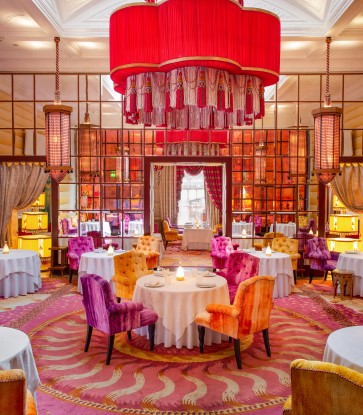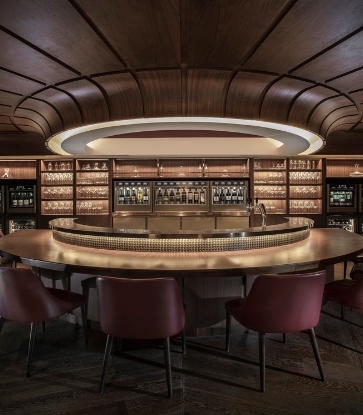One-MICHELIN-starred Ma Cuisine along Craig Road prides itself in serving “food for wine lovers” with its wine-forward culinary program that aims to deliver a non-traditional drinking experience to a new breed of wine lovers. “Our mission isn’t to educate, but to show people that wine is fun,” says Mathieu Escoffier, chef-owner of Ma Cuisine. “We want to talk to everybody about wine. From those who are starting out, those who want to learn more about wine, to those who know their wine perfectly. That's why the wine list here is very extensive. You can find wine for all budgets and for all palates.”

Lauded by the MICHELIN Guide inspectors for its French classics served family style such as the meticulously prepared escargot, whole roasted pigeon, and pâté en croûte, Escoffier waxes poetic about the beauty found in gathering friends and family together. “Especially now, after all this social distancing, people need to socialise again even more. Conversation is bound to start because there is something happening around the table. It’s a truly magical feeling.”
“There is something magical about having wine and food on a table, and you can bring anyone together from all different walks of life.”
Rooted in family
Ma Cuisine in Singapore isn’t the first of its kind. The original Ma Cuisine was established in 1996 by Escoffier’s parents at Beaune in Burgundy, which also finds itself in the MICHELIN Guide France. “It was not very common to have extensive wine lists paired with hearty and comforting food. My mother was in charge of the food, my father was the sommelier, and together, they created a beautiful combination of both worlds,” explains Escoffier.
“In Singapore, we kept the same DNA of the Beaune restaurant and refined the offerings, with convivial dishes to share. The wine list is a condensed reflection of what guests look for nowadays, with labels that are more open to the world, and not only focused on Burgundy.”
With his family background rooted in the restaurant industry, Escoffier considers himself lucky to have eaten in a lot of restaurants from a young age. “I remember not refusing to eat anything when I was young. My parents gave me a good food education, so I ate everything and anything they told me to,” he says. “Because I ate in a lot of places, I've tried many, many ingredients. I’m very lucky because I’ve always wanted to be a chef. I believe that good food is, of course, very subjective, and it is from all individual cultures. The more food you have in your repertoire, the bigger your database, and the more you can appreciate what you're eating everyday.”

The role of beef in French culture
“When it comes to cooking, beef is a huge part of the food and cooking habits of French people and chefs as well,” says Escoffier. “Recipes like pot-au-feu or bœuf bourguignon used to be known as dishes of the poor; but nowadays, they have become more refined. For example, pot-au-feu is now served with truffle, foie gras, and bone marrow. Beef also has a really good taste that’s full of umami. A simple sear emphasises the taste, and it’s delicious. It’s a protein that you can cook with minimal seasoning, but get a whole lot of flavour from.”

Escoffier says that a nostalgic beef dish to him is the classic beef tartare. “Beef tartare is such a special dish for me. I grew up eating it, and since my parents were in the restaurant industry, I was able to enjoy a lot of it growing up. It's always a very comforting dish for me, usually served with French fries or a nice salad. It used to be made table-side — with à la minute seasoning and to be eaten straight away.”

Despite his many gustatory experiences with the iconic French beef dish, there is one that sticks to Escoffier’s memory. “My favourite memory of beef tartare would have to be in 2007, it was at MICHELIN-Starred L'Atelier de Joël Robuchon. They used hanger steak, which is very unusual. Angus steak is very gamey. It’s almost like an organ, and it’s very tough. It has a lot of nerves and small parts — very hard to work with. They used a machine to break the fibres of the meat. And normally, I prefer beef tartare that’s hand-chopped, but the way they did it at L'Atelier de Joël Robuchon gave the tartare a whipped texture; it was very light — almost like a mousse. And the taste was simply amazing because it’s gamey, and we love that in France,” he fondly reminisces.

Elevated comfort with respect to ingredients
In the kitchen, Escoffier makes his own version of beef tartare and prepares it “terre et mer” style — surf and turf. According to him, the classic French beef tartare always starts with a mustard base with egg yolk, a lot of capers, gherkins, shallots, parsley, Tabasco, and Worcestershire sauce. “It has a lot of condiments and can be overpowering to the point that you don’t taste the beef anymore,” he says. In his recipe, Escoffier adapts the Italian technique of using only olive oil, lemon juice, and a bit of herbs as the base of his tartare. “I believe it’s more respectful of the main ingredient, which is beef.”

Because beef tartare is made with raw meat, its quality is very important. “It has to be fresh and of superior quality so you’re sure that there are no parasites,” he says. “My beef tartare recipe doesn’t exist anywhere. It’s fun, and I like it. Since it’s a take on surf and turf or terre et mer in French, I’m using beef, geoduck, and oyster from food purveyor Angliss. Like all other food, the secret to good dishes, I believe, comes from the sourcing of the ingredients, hygiene, and love.”

In Escoffier’s beef tartare, oysters take the form of a panna cotta, which sits at the bottom of the plate. “The tartare is made with two-thirds beef and one-third geoduck. The geoduck lends more texture than taste; there’s a bite that will contrast the melt-in-your-mouth, hand-chopped beef. So you have the oyster’s iodine, tartare, horseradish, parsley, olive oil, and lemon juice. The combination is very interesting and balanced. It’s a very different kind of texture that allows you to focus on something beyond the taste. It’s a beef tartare that you will really remember,” he says.

According to Escoffier, the secret to the perfect beef tartare is, of course, the beef. “I use beef tenderloin because as its name suggests, it is very tender. It also has to be very fresh. You cannot make beef tartare with a three-month dry-aged beef. You’re looking for bright-red beef; the tartare cannot be grey. An oxidised piece of beef is very unpleasant, and even if you cook it, you can taste it. When it's raw, it’s even worse. It's similar to how a fresh fish doesn't have to smell like fish; fresh meat doesn't have to smell like meat. It should smell clean and pure. It’s just like with wine — the oxidation of molecules gives a bitter, metallic taste, and that’s not what we want. You really want lean, pure, and fresh flavours.”

To pair with this special beef tartare is an equally special white wine. “I chose a xérès (sherry), which is a fino. It's a 2008 vintage and is aged inside a barrel under a veil of flor. The grape variety of this xérès is Palomino, and it's from a very famous plot called Macharnudo Alto, which is considered as the ‘Montrachet of Jerez’, so it's a very good wink to the Burgundy wine list we have here. It has oxidative notes, but it will push the iodine of the oysters, and it will also lift the umami of the beef. The balance will be quite interesting to taste,” he says.

A bubble of happiness
At the end of the day, what matters to Escoffier is that his guests relax, loosen up, and enjoy every minute at Ma Cuisine. “We want them to forget about the outside world for a moment and have fun. We want to make people happy and make them forget about their problems, even for just a little while,” he says. The cuisine of France is highly influenced by its culture, with the basis of it being about red wine and food. Ma Cuisine hopes to galvanise this tradition, but in a way that is more open, approachable, and understandable by the new generation of wine lovers and food enthusiasts.
“At the end of the day, I believe that if you cook the food you like, you have 99% chance of other people liking it, too.”
“When I opened Ma Cuisine, my goal was to un-complicate wine and food by focusing on the products and keeping them simple in order for our guests to both understand and enjoy our offerings,” Escoffier says. “With our experience in gastronomy, along with the combined knowledge of our sommelier and our team of chefs, we really want to create unique moments at Ma Cuisine, like a bubble of happiness around very good wine and food.”






















